Where to go in Switzerland on a short trip: Alps, lakes, and cities
Switzerland is an extremely popular country for those planning multi-stop tours around Europe, yet very few potential first-time visitors actually know specifically where they want to go. Everyone seems to know that it has the most beautiful views of the Alps and some very impressive cities, but there are actually many misconceptions among casual trip planners, so I’d like to clear most of that up below. The places to visit in Switzerland are not obvious until you’ve been there yourself or done many hours of research, so the list below should be a short cut.
I get hundreds if not thousands of itinerary questions for people who are considering a Eurail trip around Europe, and most people just include the word “Switzerland” among a list of cities like Paris, Rome, and Berlin that they want to visit. So where in Switzerland should you go if you can only make a few stops at most? I’ll answer that question below.
Note: This article was expanded and updated in February, 2024.
Switzerland is about outdoor views rather than city visits
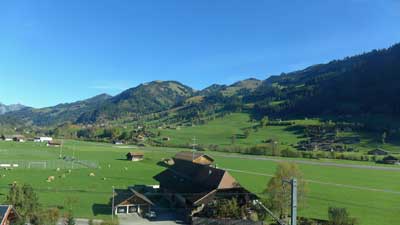 The first situation we usually run into is that people who want to visit “Switzerland” assume that the first and best (and sometimes only) stop should be its largest city, which is Zurich. Unfortunately, Zurich is the most expensive city in the world for travelers, and it’s not really very interesting.
The first situation we usually run into is that people who want to visit “Switzerland” assume that the first and best (and sometimes only) stop should be its largest city, which is Zurich. Unfortunately, Zurich is the most expensive city in the world for travelers, and it’s not really very interesting.
Geneva is a very famous city (though not for tourism reasons) on a lovely lake of the same name, but it’s also notoriously dull and lacking distinction. Rick Steves puts it well by saying that “Geneva is pleasantly situated on a lake, like Buffalo or Cleveland.” The point is, you don’t want to go to Geneva unless you’ve got something specific in mind that you want to see there.
Switzerland's cities in summary
Zurich – The largest city, very expensive, geared towards business travelers. It’s generally a pretty and very well-run city that you would enjoy if you visited, but it’s not nearly as interesting as the likes of Vienna, Munich, or of course Paris.
Geneva – Second largest city, in the French part of the country, no major sights. Again, if you visited you’d be very impressed by it and get some great photos, but it’s not worth your time unless you know someone there. There’s an impressive fountain in the lake and you can usually see it from the train as you go through the city, but it’s not really worth going there and staying more than an hour or so.
Basel – Bordering France and Germany, no major sights. It has the famous art market each year, and aside from that it’s even duller than the ones above. Again, if you visited you’d be impressed, but if you later compared photos with friends who went to the Lauterbrunnen Valley instead, you’d kick yourself for going to Basel.
Lausanne – Near Geneva in the French part of the country, very hilly, and certainly more interesting than Geneva.
Bern – The capital, compact, on a lovely river, some interesting sights and the best Swiss city to get a feel for the culture. Bern is fairly close to Interlaken (which we will discuss below) and it can be a great day trip from there, especially on a day where it is foggy and/or rainy in the mountains (and this happens a LOT).
How much time and which Swiss cities to visit?
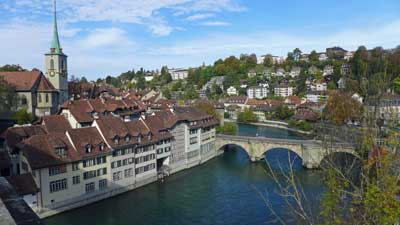 If you have 4 or fewer days in Switzerland I wouldn’t visit any of the cities listed above. If you have 5 or more days and especially if you want to include a proper city then I’d recommend 1 day in Bern or a day trip there from Interlaken. For a longer trip, and especially if you want to visit the French part of the country, then a day in Lausanne could be worthwhile.
If you have 4 or fewer days in Switzerland I wouldn’t visit any of the cities listed above. If you have 5 or more days and especially if you want to include a proper city then I’d recommend 1 day in Bern or a day trip there from Interlaken. For a longer trip, and especially if you want to visit the French part of the country, then a day in Lausanne could be worthwhile.
Many people (me included) don’t feel as if they’ve scratched the surface of a new country if they haven’t spent at least a day or two in the largest city. Zurich is certainly pleasant and a useful transit hub so spending one or two nights there wouldn’t be a major mistake. But Zurich isn’t even close to being a city like Paris, Rome, Berlin, Amsterdam, or even Vienna. If you skip it in favor of spending more time in the outdoors, you won’t be missing much.
The 2 Swiss places to focus on for short visits
Interlaken – If you want the best possible Alpine views and activities, head to the Interlaken area, which will be described in detail below.
Lucerne – The traditional Swiss tourist retreat, Lucerne is a small city with interesting culture and sights, that is gorgeously set on a lake with plenty of top activities surrounding it.
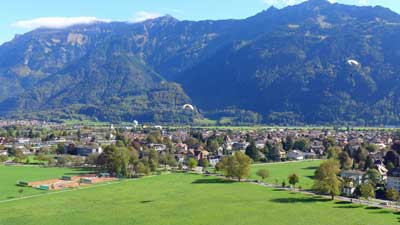 If you have 4 or 5 days and want to see the very best of Switzerland, then divide your days between those cities. They are less than 2 hours apart by direct train, so it’s easy to visit both of them even if you only have 3 days. If you only have two days, I’d pick one or the other.
If you have 4 or 5 days and want to see the very best of Switzerland, then divide your days between those cities. They are less than 2 hours apart by direct train, so it’s easy to visit both of them even if you only have 3 days. If you only have two days, I’d pick one or the other.
What about Zermatt for Alpine views?
Zermatt is a remote car-free village in southern Switzerland that is famous for being the place to see the Matterhorn mountain. It’s also a busy ski resort area, and aside from that, there isn’t much to see or do here. It’s on a private rail line, so it’s more complicated and usually more expensive to reach than Interlaken.
In other words, unless you’ve irrationally placed “Seeing the Matterhorn in person” on your so-called bucket list, skip Zermatt and head to Interlaken on a shorter visit. You won’t be sorry. If you already have enough time in your visit for the main sights around Interlaken and Lucerne and you want to also see the Matterhorn, then by all means go and you’ll enjoy it. There are quite a few other car-free villages in the Lauterbrunnen Valley near Interlaken, so they are not as novel in Switzerland as one might expect.
A weekend in Switzerland?
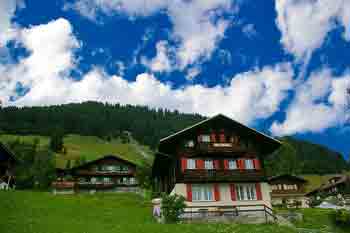 Switzerland is justifiably popular for weekend breaks among those living in Europe and if you’ve only got 2 or maybe 3 days to spend in the country and this is your first visit I highly recommend focusing on the two places mentioned just above, namely the Interlaken area and especially the Lauterbrunnen Valley, and Lucerne.
Switzerland is justifiably popular for weekend breaks among those living in Europe and if you’ve only got 2 or maybe 3 days to spend in the country and this is your first visit I highly recommend focusing on the two places mentioned just above, namely the Interlaken area and especially the Lauterbrunnen Valley, and Lucerne.
One challenge is that neither has an international airport so you’ll either be flying into Zurich or perhaps Geneva.
Train times from Zurich to Lucerne to Interlaken and back
- Zurich Airport to Lucerne: 1 hour 10 minutes by train
- Lucerne to Interlaken: 2 hours by train
- Interlaken to Zurich Airport: 2 hours 15 minutes by train
As you can see with the travel times above, Zurich Airport to Lucerne is a fairly short trip, but once you add Interlaken into the mix (even if you skip Lucerne) the travel time starts to add up for a weekend visit. With this in mind it’s probably best to just choose one of them and save the other one for another trip.
Lucerne is gorgeous, but the Lauterbrunnen Valley near Interlaken is really the star of the show, so I’d recommend going there first and doing Lucerne on another trip.
What about the Swiss Travel Pass?
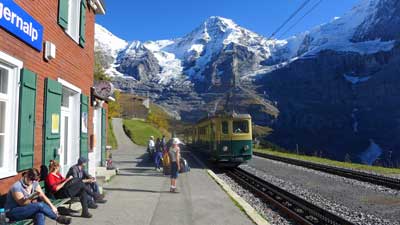 Easily the most confusing travel or city pass out there, the Swiss Travel Pass seems expensive at first, but is actually a very good deal for many people wanting to take the scenic and panoramic trains. Read our full Swiss Travel Pass review for all the details and information on where to buy.
Easily the most confusing travel or city pass out there, the Swiss Travel Pass seems expensive at first, but is actually a very good deal for many people wanting to take the scenic and panoramic trains. Read our full Swiss Travel Pass review for all the details and information on where to buy.
The bottom line is that if you are coming to Switzerland for at least 3 days and you want to take 2 or more of the amazing scenic rail journeys that the country is famous for, the travel pass is probably a good deal. It also provides 50% discounts on the Schilthorn cable car and 25% off the Jungfraujoch mountain railway. Both of those are quite expensive on their own, but extremely worthwhile, so the discount is helpful.
The Half Fare Card is probably a better deal for most people
The Swiss Travel Pass is a good deal for those who are going to be spending at least 2 or 3 days riding the rails and seeing Switzerland that way. But if you are mostly going to be focusing on Interlaken and Lucerne and the mountain sights, the Half Fare Card is the best option. For CHF120 (about US$134) you get the card that is good for 30 days and gives you a 50% discount on all trains, cable cars, mountain railways, and other sights and attractions. If you are doing either Schilthorn or Jungfraujoch, the Half Fare Card practically pays for itself with just one of those.
>>>Buy the Swiss Half Fare Card
Many people have questions about the Swiss Half Fare Card so I will explain it a bit here. You can actually buy half price train tickets for travel within Switzerland any time you want and you will see that option when you go to buy them online. The only thing is you have to have and present a valid Half Fare Card when you get on the train and are asked to see your ticket. In other words, you can buy a half fare train ticket today and buy a Half Fare Card just before you get on that train months in the future, and you are fine.
How and why visit the area around Interlaken
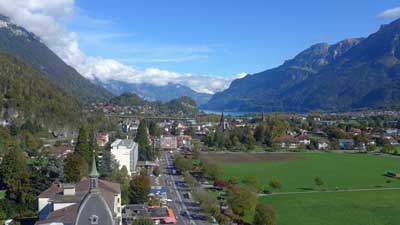 Even though I keep referring to the city of Interlaken (pronounced inter-LOCK-en) in this article, it’s really the villages in the Lauterbrunnen Valley, just above Interlaken, that you want to visit. Interlaken itself is a pleasant and scenic town that is dominated by tourism and feels more than a little out of date.
Even though I keep referring to the city of Interlaken (pronounced inter-LOCK-en) in this article, it’s really the villages in the Lauterbrunnen Valley, just above Interlaken, that you want to visit. Interlaken itself is a pleasant and scenic town that is dominated by tourism and feels more than a little out of date.
You can see everything discussed below by actually staying in a hotel in Interlaken, but it’s not the Alpine experience that you get if you stay in one of the small villages nearby. You can reach those villages in 20 to 40 minutes from the Interlaken Ost (East) train station, and it’s much easier than it sounds.
The 3 best places to stay to visit the Swiss Alps
Lauterbrunnen – A private train line runs from Interlaken Ost station to the end of its line in Lauterbrunnen. There’s a lovely waterfall here and great hiking trails, but you should probably only stay here if you can’t get to one of the villages mentioned just below. It’s a great little transit hub and it’s definitely gorgeous, so it can be worth a night if you’ve got one to spare.
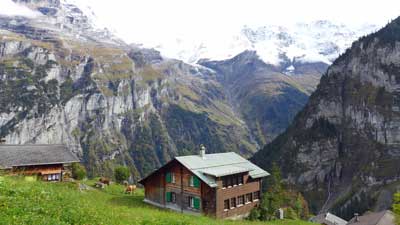 Gimmelwald – THIS is where you want to stay if you can manage it. This tiny village has one of the most stunning natural mountain settings you’ll ever see, and it feels like a time capsule that is twice as wonderful as you thought possible. If you’ve ever seen Rick Steves discussing Alpine villages, this is the one he always refers to, and his readers are some of the only guests.
Gimmelwald – THIS is where you want to stay if you can manage it. This tiny village has one of the most stunning natural mountain settings you’ll ever see, and it feels like a time capsule that is twice as wonderful as you thought possible. If you’ve ever seen Rick Steves discussing Alpine villages, this is the one he always refers to, and his readers are some of the only guests.
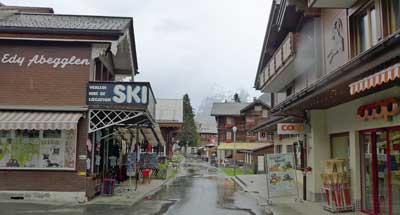 Mürren – Just one stop above Gimmelwald by cable car, Mürren has a nearly identical mountain setting, but it also has about 20 times more hotels and tourist shops than Gimmelwald. Many people will feel more comfortable here with more choices and a bit of possible nightlife, but Gimmelwald is still the perfect choice for most nature lovers on short visits to the Alps.
Mürren – Just one stop above Gimmelwald by cable car, Mürren has a nearly identical mountain setting, but it also has about 20 times more hotels and tourist shops than Gimmelwald. Many people will feel more comfortable here with more choices and a bit of possible nightlife, but Gimmelwald is still the perfect choice for most nature lovers on short visits to the Alps.
Where to stay in Interlaken and the Lauterbrunnen Valley (with pics)
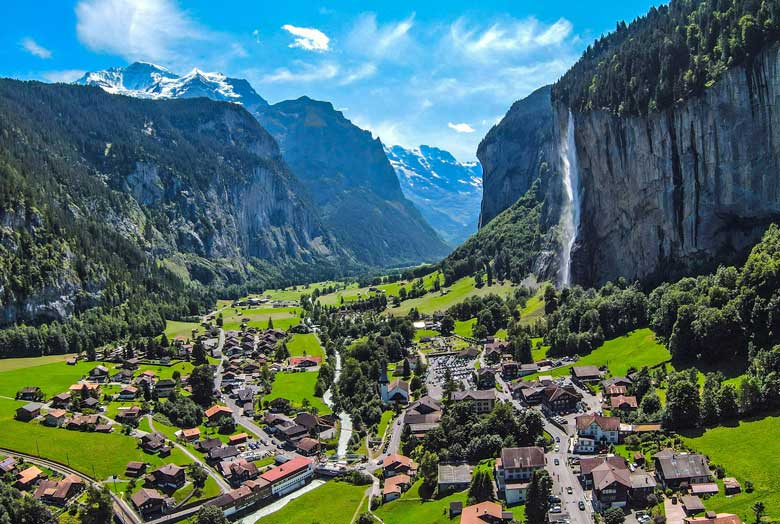
I get so many questions about where to stay in the Interlaken area that I decided to write a longer version of it and load it with huge photos so readers can get a better feel for each option. I also included recommendations for affordable and well-located photos in each area.
>>>Where to stay in Interlaken and the Lauterbrunnen Valley New for 2024!
The unforgettable things to see here (if the weather is decent)
Schilthorn observation deck and restaurant
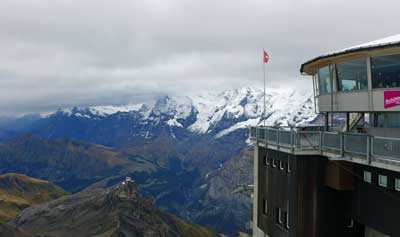 The cable cars (mountain lifts that carry up to 80 people at a time) from Lauterbrunnen to Gimmelwald and from Gimmelwald up to Mürren are short and fairly cheap, but if you keep going up two more segments to the top, you reach the Schilthorn observation deck. It’s expensive (around US$100 round-trip from Lauterbrunnen to Schilthorn) but if the weather is clear this is very worthwhile and may be your single best memory of Switzerland.
The cable cars (mountain lifts that carry up to 80 people at a time) from Lauterbrunnen to Gimmelwald and from Gimmelwald up to Mürren are short and fairly cheap, but if you keep going up two more segments to the top, you reach the Schilthorn observation deck. It’s expensive (around US$100 round-trip from Lauterbrunnen to Schilthorn) but if the weather is clear this is very worthwhile and may be your single best memory of Switzerland.
There is a rotating restaurant (with prices similar to normal Swiss restaurants) and a bizarre and anachronistic James Bond attraction based on it being a key location in the 1969 movie On Her Majesty’s Secret Service. The Bond thing is included with the lift, and it’s worth a look.
But the main thing you come here for is the 360-degree view from one of the highest peaks in Europe. Again, the weather here is key, but fortunately all the locals track the visibility on a minute-by-minute basis. If it’s clear up top while you are in the area, it would be a terrible shame to skip it based on the high price. But even if it’s cloudy up top, there are still plenty of wonderful things to see and do in the villages below.
Jungfraujoch observation area
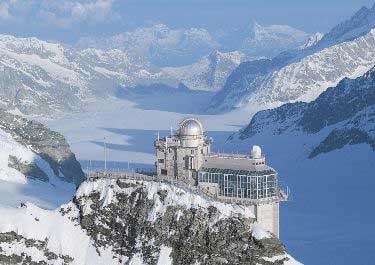 This is famously the highest railway line and station in Europe, and it’s another privately-run line that is priced as a tourist attraction rather than as transportation. The train leaves from Lauterbrunnen and takes about two chilly hours to get up to the top, including a change of trains halfway up in Kleine Sheidegg.
This is famously the highest railway line and station in Europe, and it’s another privately-run line that is priced as a tourist attraction rather than as transportation. The train leaves from Lauterbrunnen and takes about two chilly hours to get up to the top, including a change of trains halfway up in Kleine Sheidegg.
The views from the top are similar to the views from Schilthorn, from the other side of the Lauterbrunnen Valley. Once on top you can have lunch, hike, or even go sledding. It’s also quite expensive at nearly US$200 round-trip unless you have a Swiss Pass or a Eurail Pass for discounts, and it takes most of your day, but you’ll never forget the views from the top.
Harder Kulm mountain and Two Lakes Bridge Observation Deck
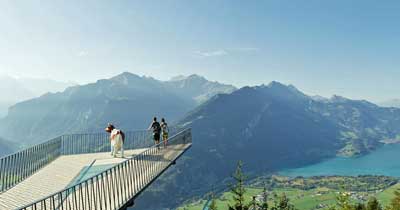 Interlaken is named after the fact that it’s located between two lakes (Brienz Lake and Thun Lake) and the best way to see them both at the same time is to take the funicular up 10 minutes to Harder Kulm and the Two Lakes Bridge Observation Deck. It costs CHF20 each way so you can take it up and walk down or vice versa to save a bit of money and have a memorable hike.
Interlaken is named after the fact that it’s located between two lakes (Brienz Lake and Thun Lake) and the best way to see them both at the same time is to take the funicular up 10 minutes to Harder Kulm and the Two Lakes Bridge Observation Deck. It costs CHF20 each way so you can take it up and walk down or vice versa to save a bit of money and have a memorable hike.
There’s a revolving restaurant about 10 minutes’ walk from the station at the top, which is definitely an unforgettable place for lunch if you’ve got time. It’s not as expensive as you might expect, at least compared to normal restaurants in Switzerland.
The Harder Kulm Railway goes from early April through late November each year. If you are only in Interlaken for one day and/or you are on a strict budget, this is the fastest and best way to get amazing Alpine views in the area.
Getting from Interlaken to Gimmelwald and Mürren
Getting up to these villages sounds complicated and time consuming, but it’s actually fast and easy once you get there. This little guide should help.
Arrive in Interlaken
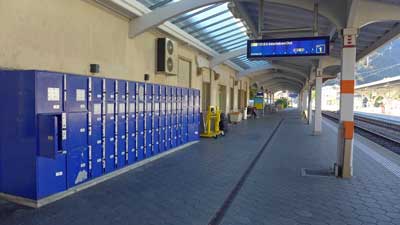 Interlaken has two main train stations, one in the west (closer to Bern) and one in the east (closer to Lucerne). If you are staying in Interlaken itself then most hotels are closer to the Interlaken West station, but if you are going up the mountain you’ll want to get off at the Interlaken Ost (East) station. All trains stop at both stations, and if you are staying at a local hotel then you get a card that allows free trips between the two.
Interlaken has two main train stations, one in the west (closer to Bern) and one in the east (closer to Lucerne). If you are staying in Interlaken itself then most hotels are closer to the Interlaken West station, but if you are going up the mountain you’ll want to get off at the Interlaken Ost (East) station. All trains stop at both stations, and if you are staying at a local hotel then you get a card that allows free trips between the two.
Once you arrive at the Interlaken Ost train station, head for the ticket windows in the office and buy a ticket to your final destination (Lauterbrunnen, Gimmelwald, or Mürren). Eurail passes are good for 25% discounts on the rest of the trip, but not for the whole thing.
From Interlaken Ost to Lauterbrunnen
The private train leaves Interlaken Ost every 30 minutes and arrives in Lauterbrunnen 20 minutes later. If you are staying in Lauterbrunnen then you are probably walking distance from your hotel when you reach the station.
From Lauterbrunnen to Gimmelwald
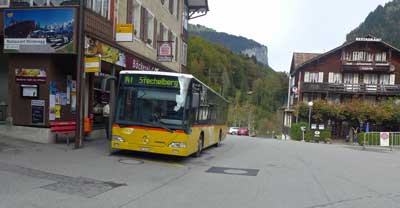 If you are going to Gimmelwald then your combined train ticket will include the price of a shuttle bus that is waiting for each train as it arrives. Show your ticket to the driver and enjoy views of the waterfall as you pass it. A few minutes later you’ll arrive at the base of the mountain at the cable car station.
If you are going to Gimmelwald then your combined train ticket will include the price of a shuttle bus that is waiting for each train as it arrives. Show your ticket to the driver and enjoy views of the waterfall as you pass it. A few minutes later you’ll arrive at the base of the mountain at the cable car station.
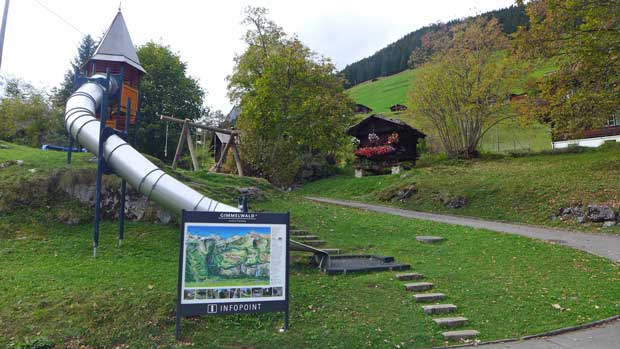 Again, the ticket you bought in Interlaken covers the whole thing, so just show your ticket at the cable car entrance and walk on in. A few minutes later the cable car will begin its fast ascent, and 5 minutes later the car lets everyone off at the base of the village of Gimmelwald. From here you are within a few minutes walk of literally the entire village and all of its hotels. The famous Mountain Hostel is directly up the path in front of you so it’s hard to miss.
Again, the ticket you bought in Interlaken covers the whole thing, so just show your ticket at the cable car entrance and walk on in. A few minutes later the cable car will begin its fast ascent, and 5 minutes later the car lets everyone off at the base of the village of Gimmelwald. From here you are within a few minutes walk of literally the entire village and all of its hotels. The famous Mountain Hostel is directly up the path in front of you so it’s hard to miss.
From
Gimmelwald to Mürren
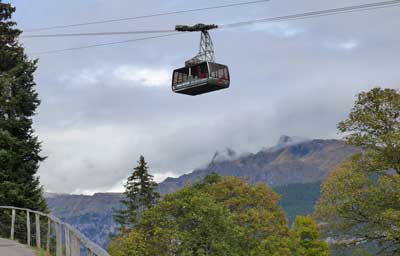 If you are staying in Mürren then you hop out of the cable car in Gimmelwald and then walk directly into the cable car across the platform, which is about to leave for Mürren. Once the door closes, you’ll be in Mürren in about 5 minutes. There is also another private rail line that goes to Mürren, but it’s slower and less scenic than the cable cars.
If you are staying in Mürren then you hop out of the cable car in Gimmelwald and then walk directly into the cable car across the platform, which is about to leave for Mürren. Once the door closes, you’ll be in Mürren in about 5 minutes. There is also another private rail line that goes to Mürren, but it’s slower and less scenic than the cable cars.
Recommended hotel and hostel in Gimmelwald
I get asked all the time about where to stay in Gimmelwald, so here it is:
Hotel: Esther’s Guesthouse
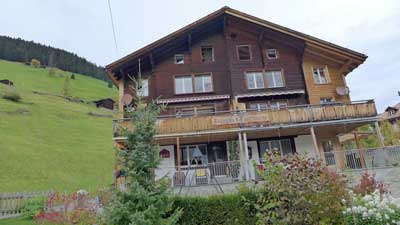 When you step off the cable car in Gimmelwald, look a little bit to the right and you’ll see a path going slightly uphill. Even if you go in the wrong direction, you’ll hit a dead end in 15 seconds, so it’s impossible to miss the road. The first thing you’ll see on your right is Esther’s Guesthouse, which is also arguably the best hotel in lovely Gimmelwald.
When you step off the cable car in Gimmelwald, look a little bit to the right and you’ll see a path going slightly uphill. Even if you go in the wrong direction, you’ll hit a dead end in 15 seconds, so it’s impossible to miss the road. The first thing you’ll see on your right is Esther’s Guesthouse, which is also arguably the best hotel in lovely Gimmelwald.
It’s run by Esther, as you might guess, and she is very friendly speaking excellent English. Each room is different and the place feels like a mountain cabin, because it is. She offers an excellent buffet breakfast in the morning, which you have to order the night before. It’s not cheap, but it’s worth it because it’s hearty and there are no other good options nearby.
Book as early as possible because this place is often the first place to sell out in Gimmelwald.
Hostel: Mountain Hostel Gimmelwald
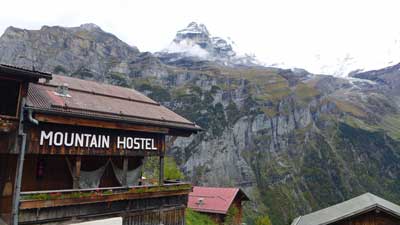 If you’ve ever wondered which hostel has the best view in the world, Mountain Hostel Gimmelwald would be at least in the Top 5, if not #1. Follow the path to Esther’s Guesthouse (above) and walk a few steps past it, and then look to the left for the short path down to Mountain Hostel. They offer fine dorm beds that are the cheapest accommodation in the village, and it’s quite a fun place in general.
If you’ve ever wondered which hostel has the best view in the world, Mountain Hostel Gimmelwald would be at least in the Top 5, if not #1. Follow the path to Esther’s Guesthouse (above) and walk a few steps past it, and then look to the left for the short path down to Mountain Hostel. They offer fine dorm beds that are the cheapest accommodation in the village, and it’s quite a fun place in general.
You won’t believe the views from this place, which are the same as from Esther’s except a bit lower and more unobstructed. This place also has a busy bar and restaurant that is basically the only “nightlife” in Gimmelwald. Many hikers get to bed early in this tiny village, but if you want to have a couple drinks and order a pizza or some local options, this is the place to go.
Again, book early because this place is always sold out.
Lucerne and what to do there
Luzern, as it’s spelled locally, is the other traditional holiday destination in Switzerland. Unlike Interlaken, Lucerne actually qualifies as a small city rather than a small resort town, so it’s a very nice contrast and very worthwhile.
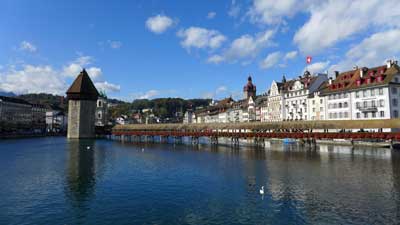 The area around Lucerne is surrounded by small mountains, but it’s not in the Alps and it doesn’t have the sort of amazing views you get in Interlaken. The main attraction here is Lake Lucerne and the various small towns on its shores. There are excellent hikes that are mostly not too challenging, and some wonderful views from nearby peaks.
The area around Lucerne is surrounded by small mountains, but it’s not in the Alps and it doesn’t have the sort of amazing views you get in Interlaken. The main attraction here is Lake Lucerne and the various small towns on its shores. There are excellent hikes that are mostly not too challenging, and some wonderful views from nearby peaks.
However, unlike Interlaken, the town of Lucerne itself is a great attraction and worth at least a day of exploration. This has always been a rich area so you can expect to find all of the high-end shops and boutiques along the small streets just north of the lake, but there are also many traditional shops and things to see that will appeal to anyone.
Recommended hotel in Lucerne
>>Hotel Des Alpes (3 stars with an amazing location and view)
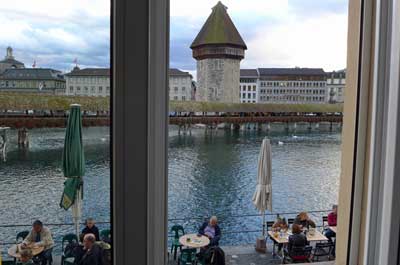 Hotels in Lucerne are not cheap, but you’ll probably spend only one or two nights there, so it’s worth paying a bit more for one of the hotels overlooking the prettiest part of the lake and the famous Chapel Bridge itself. The 45-room Hotel Des Alpes has rooms right on the water, in the heart of everything, and it’s a short walk from the train station and cruise dock as well. This place gets excellent reviews and is worth paying a bit more for unforgettable views from your bed.
Hotels in Lucerne are not cheap, but you’ll probably spend only one or two nights there, so it’s worth paying a bit more for one of the hotels overlooking the prettiest part of the lake and the famous Chapel Bridge itself. The 45-room Hotel Des Alpes has rooms right on the water, in the heart of everything, and it’s a short walk from the train station and cruise dock as well. This place gets excellent reviews and is worth paying a bit more for unforgettable views from your bed.
If this place is booked, which is often the case, then book a hotel as close to it as you can find or afford. The whole historic part of town surrounding it is lovely, with restaurants, bars, and high-end shops. There are also a couple of nearby supermarkets where you can buy inexpensive alcohol and picnic supplies to keep other costs down.
Spend a day in Lucerne itself
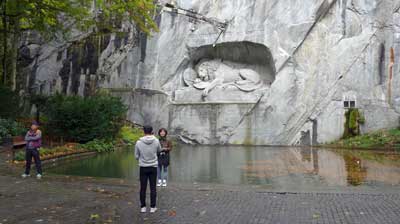 The covered wooden bridge (Chapel Bridge) that is the signature sight of Lucerne looks just as lovely when you are near it or walking across it, but there are several other historic wooden bridges just a bit upstream as well. On the north bank of where the lake becomes a river, you’ll find a string of restaurants and bars that each have excellent views. Food and drinks all over Switzerland are expensive by most standards, and fortunately the prices of the waterfront restaurants are within the normal range even though they could charge more.
The covered wooden bridge (Chapel Bridge) that is the signature sight of Lucerne looks just as lovely when you are near it or walking across it, but there are several other historic wooden bridges just a bit upstream as well. On the north bank of where the lake becomes a river, you’ll find a string of restaurants and bars that each have excellent views. Food and drinks all over Switzerland are expensive by most standards, and fortunately the prices of the waterfront restaurants are within the normal range even though they could charge more.
Most of the interesting part of Lucerne is in the area behind those restaurants, and it’s certainly worth doing a self-guided walking tour if not a guided one. Heading farther east you’ll come to another older part of town where the famous lion statue is located. You can’t visit Lucerne without having a look at the lion, and fortunately it’s easy and quick to reach (and it’s free).
Take a lake cruise of some kind
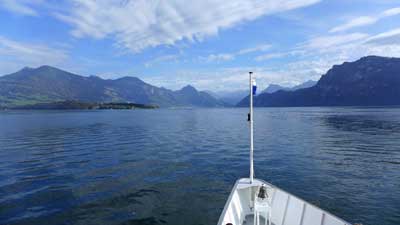 The main lake-cruise boats leave from just in front of the train station, and at the very least it’s worth doing the simple round-trip of about one hour where you don’t even leave the boat. If you have most of a full day you have up to 35 different options of stops to disembark and walk around before catching another boat back to Lucerne.
The main lake-cruise boats leave from just in front of the train station, and at the very least it’s worth doing the simple round-trip of about one hour where you don’t even leave the boat. If you have most of a full day you have up to 35 different options of stops to disembark and walk around before catching another boat back to Lucerne.
Especially in nice weather, even the short lake tour is lovely, and if you have more time you can jump off at Vitznau and do the scenic hike up Mount Rigi. There are also small lakeside villages that are ideal for a stroll and lunch stop. Long story short, there are dozens of interesting sightseeing options that are available using part of the boat tour, and the views all around are wonderful.
Visit Mount Pilatus
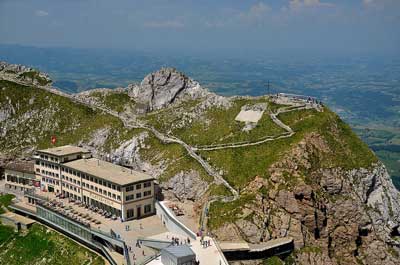 The tallest mountain around Lucerne is just behind the city, and it’s also extremely popular for hiking, although you don’t actually have to walk up or down if you don’t want to. You can take the steepest cogwheel train in the world up to near the summit (except in winter), and there is also a gondola and cable car going to the same place all year round.
The tallest mountain around Lucerne is just behind the city, and it’s also extremely popular for hiking, although you don’t actually have to walk up or down if you don’t want to. You can take the steepest cogwheel train in the world up to near the summit (except in winter), and there is also a gondola and cable car going to the same place all year round.
You can take the cogwheel train up and have a more or less flat hike around the summit area, and then take the gondola and cable car back down again. You can do them in the other order, and the cost is the same either way. At around US$65, this is not a cheap hike, but like most everything in Switzerland, the quality is high so it doesn’t feel like a rip-off. You can reach the cable car in 10 minutes on a public trolly bus from Lucerne.
Visit Mount Rigi
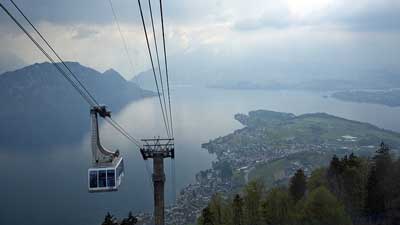 Not technically part of the Alps, Mount Rigi overlooks Lake Lucerne and is the easiest peak to reach in the area. The boat tours that leave from Lucerne include stops in both Weggis and Vitznau where you can hop on or off. There is a cable car from Weggis that goes up to the Rigi summit and a train that goes between Vitznau and the summit. Many people take one up and the other down.
Not technically part of the Alps, Mount Rigi overlooks Lake Lucerne and is the easiest peak to reach in the area. The boat tours that leave from Lucerne include stops in both Weggis and Vitznau where you can hop on or off. There is a cable car from Weggis that goes up to the Rigi summit and a train that goes between Vitznau and the summit. Many people take one up and the other down.
Unlike the other peaks mentioned in this article the Swiss Travel Pass covers both ways to get up and down for free. The others are 50% off with the Swiss Travel Pass or Half Fare Card, except for Jungfraujoch, which is only 25% off with the Swiss Travel Pass and still 50% off with the Half Fare Card.
Visit Mount Titlis
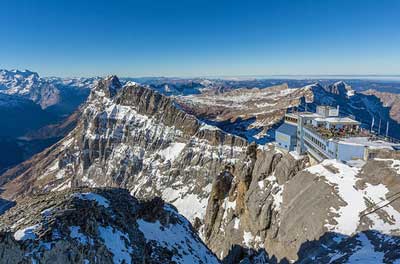 A bit south of Lucerne, Mount Titlis is an Alpine peak that is the most dramatic in the area. Once up at the top you can experience the Titlis Cliff Walk, which is the highest suspension bridge in the world. It’s a free pedestrian bridge over 3,000 meters up that allows for amazing views of the area, as long as the weather is clear.
A bit south of Lucerne, Mount Titlis is an Alpine peak that is the most dramatic in the area. Once up at the top you can experience the Titlis Cliff Walk, which is the highest suspension bridge in the world. It’s a free pedestrian bridge over 3,000 meters up that allows for amazing views of the area, as long as the weather is clear.
You can reach Titlis by taking a 43-minute train ride from Lucerne to Engelburg and then taking the cable car up from there. As with the others, it’s wise to check the weather immediately before you are going to depart because it can be foggy or cloudy any time of the year, but usually not for whole days at a time.
Additional photo credits
Jungfraujoch by cupweuro on Flickr, Pilatus by Tony Fernandez on Flickr, Rigi by Kosala Bandara on Flickr, Titlis by PaulSchliebs on Flickr

Hi Roger,
Thanks for your great advise, I think we’ll switch to Interlaken since it is closer to Schilthorn,
We’ll put Rhine Falls in 3rd day as you suggest as well,
Another question about the weather, is it possible to get snow at Schilthorn in 20 – 23 October or perhaps we need to change Mt Rigi to Mt Titlis to get all year snow ?
Dedi,
There is usually snow at the top of Schilthorn all year round, but it’s not as much as on Jungfrau across the valley. The ski season typically starts in mid December. Still, you might get more snow on Schilthorn if you get lucky. I’ve heard that Titlis often has snow in summer. Most likely they will all have it or just Jungfrau. You will also probably know at least a month before you go and you can check the webcams at the top of each peak that are online. That way you can change your plans a bit if you need to. Have a great trip. -Roger
Hi Roger,
First of all, many thanks for sharing these 2 great arcticles on swiss pass & where to go in Switz,
We are planning to visit Switzerland and the end of our 2 weeks Europe trip in next Mid October 2019, this is our first time going to Europ btw,
Taking your consideration in both posts, we are planning to take 3 day swiss travel pass and would like to maximize the value & minimize any additional transport cost (or make it zero by any chance) with below itinerary :
Day 0 :
take train from Frankfurt to Bern and stay for 3 nights nearby the main station & kept our luggage there
Day 1 :
[morning to noon], go to interlaken – lauterbrunnen and take Schilthorn course
[afternoon to evening], take Golden Pass scenic rail from interlaken to Montreaux to visit Chillon Castle and then head back to Bern at night
Day 2 :
[full day] trip to lucerne, go to Mt. Rigi with cable car / cogwheel and take lake cruise
Day 3 :
[morning to noon], checkout & take our luggage out
[afternoon to evening], take train from Bern to Zurich and spend last night in any hotel nearby the airport before flight back to Jakarta at the next day
I would like to seek for your advice on:
1. With above overall itinerary – are we correct to choose Bern as transit cities during our visit in Swiss?
2. On Day 1,
a. How long usually does it take to run through Schilthorn course ?
b. does this partial golden pass from interlaken to Montreaux fully covered by Swiss Pass and do you have any information about the time tables?
I’ve tried to check & download one from the websites but unfortunately it was not written in english – however if I read it correctly there is one train scheduled departing from interlaken OST at 12.55 and reach Montreaux at 16.13 which we’re planning to take if possible,
3. On Day 3,
Do you have any advise for interesting places / activities to spend our half day time while carrying probably 2 mid to large size suitcases luggage with active swiss pass? any interesting place with coin locker should be great.
My apologize if the question is a bit too much & thanks for your help!
Dedi,
I’m glad this is helpful.
Bern is only about an hour from Interlaken and also from Lucerne, and the train service in Switzerland starts early and runs reliably, but I think you’ll miss staying in those towns. Bern is charming for a large Swiss city, yet it feels nothing like those mountain towns you’ll be visiting during the day. I prefer Bern to Zurich, but I think you’d enjoy Interlaken and Lucerne much more if you stayed in them.
From Interlaken Ost train station it takes about two hours to reach the top of Schilthorn. It takes about an hour to get from Interlaken to the bottom of the cable car, and about an hour riding up.
The Goldenpass is part of regular Swiss rail lines, and part of them are covered by panoramic carriages on a few departures each day. You have to pay a small supplement to reserve a seat in the panoramic carriage, but if you ride in normal seats it’s all included with the Swiss Travel Pass. The panoramic carriages run only between Zweisimmen and Montreux and it looks like there are 6 per day at the moment. They leave Zweisimmen at 08:25, 10:25, 12:25, 14:25, 17:05, and 18:25. From Interlaken to Zweisimmen you’ll take a normal fast train and it takes about 70 to 90 minutes.
On Day 3 you could put your bags in luggage lockers or left-luggage offices in any large train station, and then head to Rhine Falls, which is about an hour from Zurich Airport and some of the attractions there are covered. That is probably the best attraction close to Zurich or the airport, and it’s quite different from the other places. Let me know if you have any other questions. -Roger
Thank you so much for replying! This is so helpful!!
Hi Roger,
Thank you for responding to my queries. Swiss travel pass can cover most things in Switzerland. As I will spend 2 weeks and use public transport mostly. Would you advice to get EUrail pass as well? or it will be better to just buy train tickets separately?
Thank you,
Abhinav Lad
Abhinav,
You are almost certainly better off just buying those other train tickets individually, as far in advance as possible A Eurail Pass can be good value for longer trips where you want to make plans as you go, but the per-day cost is quite high so buying the super-saver tickets a month or two in advance is almost always cheaper. Also, in France (and Monaco) the seat reservations on the high-speed trains are quite expensive with Eurail Passes. Check the fares for the trains you want to take at least a month or so in advance. Most likely they’ll be much cheaper than a Eurail Pass. -Roger
Hi Roger,
First of all, great article and thank you for including all the details in the post.
Our plan, we are planning 2 weeks Europe trip and have 3 days for Switzerland. Earlier I was planning to take Eurail pass for 2 weeks but it looks like it’s not going to cover most places in Switzerland. Countries I am planning to visit are Netherland, Belgium, France, Monaco, Switzerland, and Italy. Planning to start from Netherland and make our way down to Belgium, France (Paris, Nice), Monaco. From Monaco, travel to Switzerland (below itinerary for the same). From Switzerland to Italy and return back to Canada.
We are planning to travel via train mostly or use public transport within cities. Which pass would you recommend?
Below is the itinerary for Switzerland:
Travel from Monaco to Interlaken or Gimmelwald (if we get a place to stay) nothing for that day as it will be 9-hour long journey.
Early morning Schilthorn observation deck and Jungfraujoch observation area.
Do you recommend visiting both place? Or anyone would do? Also, is it possible to do both in a day?
More will be exploring town and stay here in night.
Next day early morning, leave for Lucerne: Explore mountains here and city of lake
I am confused on which mountain to visit here as I all 3 sounds amazing :slightly_smiling_face: What all I can cover in a day timeframe?
Staying here in night
Travel to next place somewhere in Italy mostly Venice.
Can you please help us with Itinerary? I can also spend 1 extra day if required.
Thank you so much for your help!
Abhinav,
I’ll try to answer your questions in order…
It’s possible to do Schilthorn and Jungfraujoch in the same day, especially if you do Jungfraujoch as early in the morning as possible, but I wouldn’t recommend it. They are both quite different from each other, but both involve a LOT of traveling and that would be a rushed day to go up the peaks on the opposite side of the same valley. If you get a Swiss Travel Pass then Schilthorn is fully included, while Jungfrau is only a 25% discount. There are so many lovely things to see around there that it would be a shame to rush to just see the mountain peaks. Also, on any given day it can be foggy on the top, although usually for only part of a day. So you might not have time to do them both anyway.
Near Lucerne it’s nice to see Mt. Rigi because you can go up as part of the lake cruise. There is a cable car going up and also a cogwheel train so most people go up one and come down the other. Both are covered by the Swiss Travel Pass, as is the boat ride.
I’d stay an extra day in the Interlaken area if you can. Honestly, just hiking around the Lauterbrunnen Valley and visiting some of the villages (Lauterbrunnen, Gimmelwald, Murren, Wengen, Grindelwald) is a lovely day that you’ll never forget. There is another cable car that goes up behind Wengen so you can hike down. That is another wonderful way to spend a few hours, and it’s also covered by the Swiss Travel Pass. Based on what you are planning I think I’d get the 3-day Swiss Travel Pass, especially if you do the things I mentioned. Just taking the trains around Interlaken and the boat ride around Lucerne can be expensive so the Pass should pay for itself pretty quickly. Let me know if you have any other questions. -Roger
Hi Roger! I was hoping to stop by Switzerland for a day during my trip to Europe. I will be coming from England and going to Amsterdam. Since it’s my first time, I really don’t know how to go about getting to the right Swiss airport to be able to do a scenic train ride and be back for a flight to Amsterdam. I’m doing my research but I would love your help because our duration in the country is pretty small and we want to squeeze in a train ride (my dad’s request). Thank you so much!
Bani,
This is an interesting question. Most of Switzerland’s “scenic trains” are one-way routes that take 3 to 7 hours in each direction, so doing them both ways would take a whole day or more. What I’d recommend instead if you’ve got most of a day is to fly into Zurich early in the morning and then take a train from Zurich Airport to Interlaken (two hours each way), and then go up the Schilthorn cable car or Jungfraujoch mountain railway before heading back to Zurich Airport in the late afternoon. Schilthorn takes less time as it’s a one-hour (in each direction) cable car, while Jungfraujoch takes more than two hours up and more than two hours back. Also, you could get a Saver Day Pass for that day and all of your train travel plus Schilthorn would be fully included for one reasonable price. Those passes are discussed in the main article about the Swiss Travel Pass.
The only other major airport in Switzerland is in Geneva, which is on a lovely lake, but it’s farther from the best Alps views and experiences. Let me know if you have any other questions. -Roger
Thank you Mr Wade for this wonderful blog/website of yours. I’ve been reading it more the last few days + the questions people have posted. It’s really helping me to put together our planned Switzerland trip this late August. As of now, we don’t know if we’ll be flying directly into Zurich on the afternoon of the 27th, or by train to Basel (from Mainz). We are in our early 60s and love to hike (we did the Camino & Englands Coast to Coast), so the Berner Oberland Interlaken area is a place we’ll spend 4 full days, 5 nights in. We’ll also spend our first 2 nights in Bern,; whichever way we arrive. We’ll have 15 days to see the country, so should we go from Bern to the Lake Geneva area (3 nights) first, or go to Interlaken? We really want to use the Swiss Pass, so we’ll take three of the Scenic train routes…..a night in Moritz, also Zematt & Lucerne. Can I also add Lugano to this and still get in some of the featured hikes in those areas? Which itinerary would be most logical? PS we tend to stay in hostels or private rooms in houses featured on Airbnb Thanks!
Lou,
This trip sounds amazing and I’m glad this has been helpful. As mentioned near the top of the article, Switzerland’s cities are nice, but they don’t compare to the amazing scenery in the Alps and elsewhere so I’d try to focus on that. You’ve probably read about the weather issues in that the top of the highest peaks can be foggy on any day of the year, although usually only for half a day or so at a time. With that in mind you might save Bern for a backup plan or towards the end of your stay. You can reach Bern from Interlaken on the train in around an hour, and trains leave about three times each hour. So if you wake up in Interlaken and it’s foggy at the top of the mountain you wanted to see you can just hop on the train and be in Bern for a day visit.
The 14-day Swiss Travel Pass is an excellent deal for those staying that long, and it will allow you to do many more train rides than you might think. As you might know, the Swiss trains are famously punctual and comfortable, so if you can ride them for free I think you’ll choose to ride around quite a bit.
With a stay that long you’ll have no trouble seeing every corner of Switzerland, so I don’t think you need to find the most efficient route. Personally, I would start in Interlaken and Lucerne (as those are the biggest highlights) and make sure you have time to do everything you want in those areas. You’ll have plenty of time to do the Goldenpass to Geneva after that and Zermatt as well.
For Lugano you might consider doing the Bernina Express train, which ends with the Glacier Express Bus to Lugano. You can stay a day or two and then take a more direct train back to your next Swiss destination. I really envy you. I’m not sure how much help this was, but I guess my main point is that in two weeks you’ll have plenty of time to see it all. And the Swiss trains are so pleasant and punctual that it’s really a pleasure to ride them around a lot. That isn’t true in most European countries. -Roger
Hi Roger,
LOVE YOUR POST. It has lots of information that I would have never thought off.I am planning a weekend trip( 2 nights, 3 days) out of my work trip and I read your post.
Mostly Interlaken and Lucerne seem the places to go to. Can you advise on what we should focus more in those limited days. It is our first time and we will probably be flying in and out of Switzerland.
Here is my plan:
Day 1 Interlaken – Grimmelwald
Schilthorn observation deck and restaurant
Jungfraujoch observation area
Day 2 Lucerne
Mt Pilatus, Titlis and maybe do a cruise?
Day 3- Not sure
this would be a short day since we would be heading back to Rome Italy.
What do you think ? Please let me know.
Vanessa,
I’m glad this has been helpful. I’d definitely focus on Interlaken and specifically the Lauterbrunnen Valley (Schilthorn and Jungfrau are on opposites sides of the valley). The tiny village one stop up the Schilthorn cable car is called Gimmelwald, which is easily confused with the village across the valley called Grindelwald. If you are starting in Gimmelwald you can get to the top of Schilthorn in less than an hour and you’d want to spend at least an hour on top and then an hour down. Most people spend about 4 hours total up and down, partly because the cable cars only leave every 30 minutes so you’ll end up waiting a bit.
Jungfraujoch is on the other side of the valley so you have to go back down to the village of Lauterbrunnen and then get a short train ride to Wengen or Grindelwald to get the train up to Jungfraujoch. Going up and down that side usually takes 5 or 6 hours and trying to do both in the same day will feel kind of rushed. Also, if you just focus on the peak attractions you’ll miss almost everything else in between, so I’d do one per day or just one in general.
Lucerne is a similar situation in that there are 3 famous peak attractions that many people focus on, and doing more than one per day can be challenging. I’d do one per day and take your time so you can stop off for excellent views and shopping and a bite to eat at places on the way. The scenery in the whole area is pretty amazing, and the weather on top of the peaks is foggy at times so sometimes it’s the worst place to be. The lake cruise leaving from in front of the Lucerne train station is a great way to see the area and also reach the train and cable car up Mt. Rigi. I’m happy to help if you have other questions. -Roger
Hi Roger,
Thank you for what has been the most helpful article for me so far! Me and my husband are planning a trip from 4th June to 11/12th June. Can you suggest the best, most scenic places to visit? Also what would be the weather as we have heard it will be rainy. My husband was suggesting we do Switzerland for 4-5 days and 3-4 days in some other place in Europe but I was keen on Switzerland itself. We were also planning to do Chamonix and Switzerland, but were told by a few people to do only Switzerland instead. Would appreciate your help/insight on this. Thank you so much!
Regards,
Anvi
Anvi,
Switzerland really does have the best Alpine views in Europe, but France, Italy, and Austria all really have nice views as well. I’d focus 3 or 4 nights in the Interlaken area as the main part of your trip. The Lauterbrunnen Valley is stunning and filled with great views and hikes and such. You could also spend 2 or 3 days in Lucerne, which is different and yet still very scenic. The article above was written to provide the best options for most first-time visitors.
It’s true that the summer months are the rainiest months in the Alps, but it rarely rains for very long and you also have those long days so it’s a very popular time to visit. Having an umbrella handy is wise, and you can usually do whatever you want.
Again, there is no right or wrong answer and there are many excellent views of the Alps. Switzerland is quite expensive, even compared to France, so that is something to think about. I’d definitely plan 3 nights in the Interlaken area (probably in Murren, Gimmelwald, Wengen, Grindelwald, or Lauterbrunnen), and two nights in Lucerne. You might also visit Bern and/or take a train ride to Geneva or Lausanne for great views of the lake and other mountains. I also hear Chamonix is nice, but if you don’t speak French it might be a little challenging. -Roger
Hi Roger,
Your article on where to go in Switzerland has been a lifesaver!
I’m after some advice on how to get to & from our destinations.
We have a flight booked from Nice to Geneva on the 22nd June but we are wanting to get to the Interlaken area (Gimmelwald or Murren – 3 or 4 nights) then go onto Munich (2 nights).
We would like to visit both the Jungfraujoch & Schilthorn.
Do you think the easiest way is to buy the Half Fare Card (Swiss Travel Pass) then train from Geneva-Interlaken-Munich or buy individual train tickets?
Thanks in advance!
Rosanna,
I’m happy that this information has been helpful. If you want to do both Jungfraujoch AND Schilthorn then I think the Half Fare Card will be the best value. Since it gives a 50% discount on Jungfraujoch instead of the 25% discount you get from the Swiss Travel Pass, I think it would save the most money. Train tickets within Switzerland are all the same price no matter when you buy them, but the train from Switzerland to Munich will be cheaper the sooner you buy the ticket. You’ll need to take a train from Interlaken to Bern and then change for a train to Zurich and there you can get an international train bound for Munich. It looks like there is a direct bus from Zurich to Munich that takes only 3 hours 43 minutes, compared to over 5 hours by trains.
Either way, you can use your Half Fare Card on all journeys up to the Swiss border. Let me know if you have any other questions. -Roger